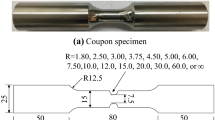Based on large-scale experimental tests performed on cruciform specimens made of French type RPV steel, the warm prestressing (WPS) effect for LCF (load–cool–fracture) and LCTF (load–cool–transient–fracture) load cycles is studied by finite element simulation. The modified Beremin model is used to determine the fracture probability of the specimens.








Similar content being viewed by others
References
W. Lefevre, G. Barbier, R. Masson, and G. Rousselier, “A modified Beremin model to simulate the warm pre-stress effect,” Nucl. Eng. Design, 216, 27–42 (2002).
R. Beleznai, G. B. Lenkey, and D. Lauerova, “Calibration of three-parameter Weibull stress model for 15Kh2NMFA RPV steel,” J. Nucl. Mater., 406, 119–126 (2010).
Author information
Authors and Affiliations
Additional information
Translated from Problemy Prochnosti, No. 4, pp. 135 – 142, July – August, 2013.
Rights and permissions
About this article
Cite this article
Beleznai, R., Szavai, S. Application of the Beremin Model for Cruciform Specimen to Determine the Fracture Probability in Case of WPS. Strength Mater 45, 489–494 (2013). https://doi.org/10.1007/s11223-013-9484-8
Published:
Issue Date:
DOI: https://doi.org/10.1007/s11223-013-9484-8




